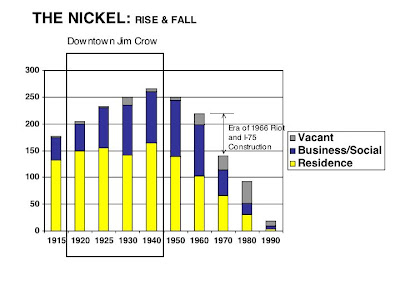The Nickel being West Fifth Street, west of the river. The black buisness district.
The black business district was a feature of African American urban life, probably best known in places like Atlanta, with Auburn Avenue, but also in other cities too. Dayton had one on West Fifth, developing as this neighborhood evolved into a black ghetto.
The map below shows West Fifth (shaded in yellow) as it was in the late 1940s. There was a buisness district on West Third, too, which is pretty evident as the built-up area on the upper part of the map.
An in-depth analyses is in progress, but will take some time as this was a fairly complex development evolution, with a lot of building subsitution and mixed use (not really that evident at first glance).
But here is a first look, doing a count of residential and business addresses from the city directory, as well as vacancy showing how this street grew.
The bar chart shows five year intervals for the early years as this was the period of the Great Migration (starting in 1910), with a big increase in migration from the rural South to the urban North. In Dayton there was also an informal Jim Crow policy keeping blacks out of downtown public accomodations. There might have been a relation to the increase in business on Fifth during the same era.
Then there was the first big drop in the 1960s, which was an era of riots and also freeway construction removing the eastern reaches of the Nickel.
After 1970 vacancies and demolitions increased until the street was all but gone by 1990 (and it is completely gone today except for maybe three or four buildings). Another look, showing trends by type of use. It's interesting to see the residential numbers drop during the postwar era, even before the 1960s disruptions. Businesss use was pretty stable for 30 years after 1930, but crashing after 1960.
Another look, showing trends by type of use. It's interesting to see the residential numbers drop during the postwar era, even before the 1960s disruptions. Businesss use was pretty stable for 30 years after 1930, but crashing after 1960.
This is interesting as it could mean there was increasing poverty in the black community, thus less disposable income, due to jobs starting to disappear. But it could have been just a simple thinning out of an overcrowded neighborhood as new neighborhoods were opened to black settlement.
The first black postwar expansions was new housing on empty platted land off Lakeview, Germantown and McCall, in the late 1940s. The first large white area opened in the postwar era was Westwood, in the 1950s, and this corresponds with a decrease one sees between 1940 and 1960.
The tale of black expansion and white flight is another story, but one can see how it might have had an effect Fifth Street.
Next, a few posts looking at the Nickel in detail; the world of social clubs, pool halls, shoeshine parlors, barbershops, movie theatres, churches, all the richness of an urban neighborhood of the early and mid 20th century.
Thursday, February 19, 2009
Walking the Nickel: A First Look
Subscribe to:
Post Comments (Atom)

2 comments:
Jeff, thanks for doing this analysis. I look forward to your future posts on this. Margaret Peters has done an excellent history of the Nickle, including a map with known businesses over time. It was quite the place . . . almost a mini-Harlem. The Palace Theater hosted greats such as Duke Ellington, Sarah Vaughn, Cab Calloway, Count Basie, Louie Armstrong and others. One thing that's interesting to me. I have yet to come across pictures showing the street scape of 5th in those days. There are pictures showing individual businesses, but nothing showing the street scape. I asked Ms Peters about that, and she agreed. She hasn't found anything either, which is strange. There are tons of photos showing the street scape of West Third, but nothing on Fifth.
The map is framed and hanging in that old YMCA building on 5th (I think its the Urban League offices or something now). It looks like a snapshot of maybe the 1950s or late 1940s. I know its in her book, too.
I have seen one photo of 5th, and its of some houses on 5th. Don't recall where I saw it though.
There are some aerials but they are grainy. And the Sanborn maps, which permits a rough imagining of what it might have been like, but without the necessary detail to give a true flavor of the street.
Not sure what or how I am going to post on on this, to be honest, as there is nothing to show, or not much, to illustrate things.
Post a Comment